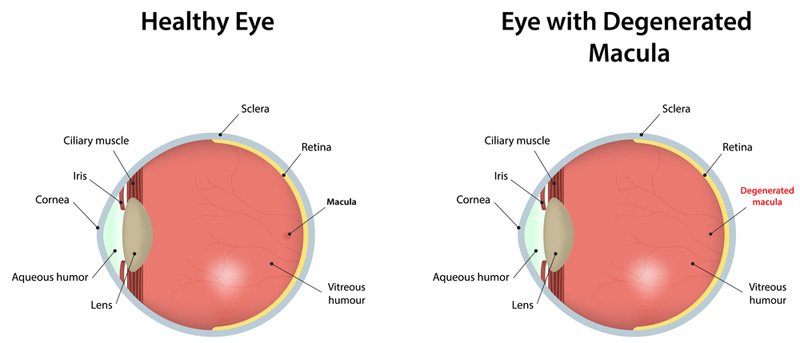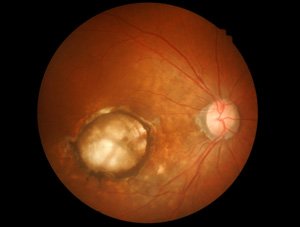What is Macula?
The retina is a paper-thin tissue that lines the back of the eye and sends visual signals to the brain. In the middle of the retina is a tiny area called the macula. The macula is made up of millions of light-sensing cells that help to produce central vision. The macula allows us to appreciate the detail and perform tasks that require central vision such as reading, sewing, driving and colour vision.
What is Macular Degeneration (AMD)?

AMD is a common eye disease mostly seen in people over the age of 50 years that gradually destroys sharp, central vision. In some cases, AMD advances so slowly that people notice little change in their vision. At this stage, it may be detected on routine retina check-up. But in others, the disease progresses faster and may lead to a loss of vision in one or both eyes. AMD usually involves both eyes, although one may be affected long before the other. AMD causes no pain and almost never leads to total blindness.
How does AMD lead to vision loss?

AMD is of two types:
- Dry AMD: More common type. 90 percent of all people with AMD have this type. There is a slow atrophy of macula, leading to a gradual loss of central vision.
- Wet AMD: Although only 10 percent of all people with AMD have this type, it accounts for 90 percent of all blindness from the disease.
As dry AMD worsens, the formation of abnormal, fragile blood vessels causes “wet” AMD. These new blood vessels often leak blood and fluid under the macula. This causes rapid damage to the macula that can lead to the loss of central vision in a short period.
Who is at risk of developing it?
At the moment the exact cause for AMD is not known. However, there are some risk factors, which have been identified.
- Age: AMD is an age-related condition, so growing older makes the disease more likely.
- Gender: Women are more affected than men
- Genetics: There appear to be a number of genes, which can be passed through families which may have an impact on whether someone develops AMD, or not
- Smoking: A definite risk factor. Stopping smoking can reduce the risk of macular degeneration
- Sunlight: Blue rays of sunlight may accelerate macular degeneration. It is a good idea to wear sunglasses with UV filters to protect the eyes during outdoor activities
- Nutrition: Research suggests that supplementation with antioxidants like Vitamin C and E, and minerals like zinc and selenium can help protect against macular degeneration.
The symptoms may not be noticeable in early Dry AMD if only one eye is affected, to begin with. In the early stages your central vision may be blurred or distorted, with objects looking an unusual size or shape and straight lines appearing wavy or fuzzy (Metamorphopsia). This may happen quickly or develop over several months. People with the advanced stage will often notice a black patch or dark spot in the centre of their sight. This makes reading, writing and recognizing small objects or faces very difficult.
There may be a sudden painless loss of central vision when wet AMD develops.
Can AMD be detected in time?
AMD is a slowly progressing disease is detected mostly on a routine ophthalmological evaluation. The comprehensive eye exam includes:

- Visual Acuity Test
- Dilated Eye Exam to examine your retina and optic nerve for signs of AMD and other eye problems
- Amsler Grid: The pattern of the grid resembles a checkerboard. You will cover one eye and stare at a black dot in the center of the grid. While staring at the dot, you may notice that the straight lines in the pattern appear wavy. You may notice that some of the lines are missing. These may be signs of AMD.
- Fluorescein Angiogram: In this test, a special dye is injected into your arm. Pictures are taken as the dye passes through the blood vessels in your retina. The analysis allows your eye care professional to identify any leaking blood vessels and recommend treatment.
- Optical Coherence Tomography: This gives the cross-sectional image of macula identifying the exact location of the choroidal neovascular membrane beneath the macula.
How can AMD be prevented?
AMD cannot be prevented. Early diction is essential to prevent severe visual loss. Protecting your eyes from the sun, eating a well-balanced diet with plenty of fresh fruits and vegetables and stopping smoking may all help to delay the progress of AMD.
What are the treatment options?
- Dry AMD: Once dry AMD reaches the advanced stage, no form of treatment can prevent vision loss. However, treatment can delay and possibly prevent early dry AMD from progressing to the advanced stage, in which vision loss occurs. Nutrition and antioxidants- The role of antioxidants is not clear, but supplementation with Lutein, zeaxanthin, Vitamin C and E and other minerals has shown a beneficial effect in slowing the progression of the disease. Quit smoking.
- Wet AMD: Wet AMD can be treated with laser surgery, photodynamic therapy, and injections into the eye. None of these treatments is a cure for wet AMD. Each treatment may slow the rate of vision decline or stop further vision loss, but the disease and loss of vision may progress despite treatment
- Laser Photocoagulation: This procedure uses a laser to destroy the fragile, leaky blood vessels. A high energy beam of light is aimed directly onto the new blood vessels and destroys them, preventing further loss of vision. However, laser treatment also may destroy some surrounding healthy tissue and some vision. Only a small percentage of people with wet AMD can be treated with laser surgery. Laser surgery is more effective if the leaky blood vessels have developed away from the fovea, the central part of the macula.
- Photodynamic Therapy: A drug called verteporfin is injected into your arm. Next, a light is shined into your eye for about 90 seconds. The light activates the drug. The activated drug destroys the new blood vessels and leads to a slower rate of vision decline. Treatment results often are temporary. You may need to be treated again.
- Transpupillary Thermotherapy: A special type of laser is used to heat up the membrane without destroying the overlying retina.
- Injections (Anti VEGF therapy): Wet AMD can now be treated with a new drug that is injected into the eye (anti-VEGF therapy). Abnormally high levels of a specific growth factor occur in eyes with Wet AMD and promote the growth of abnormal new blood vessels. This drug treatment blocks the effects of the growth factor. You will need multiple injections, usually given about six weeks apart. The eye is numbed before each injection. After the injection, you will remain in the doctor’s office for a while, and your eye will be monitored. As with photodynamic therapy, the main benefit for patients treated with the drug is to slow vision loss from AMD.
In case if you suspect of having AMD, please visit the page to know more about retina department and super-specialists at Eye7 Chaudhary Eye Centre and book an appointment as soon as possible.

